Changes to Material Phase and Morphology Due to High-Level Molybdenum Doping of ZnO Nanorods: Influence on Luminescence and Defects
Abstract
1. Introduction
2. Experimental Techniques and Conditions
2.1. Samples Preparation
2.2. Experimental Techniques Used for the Characterization of Samples
3. Results and Discussion
3.1. Identification of Material Phases and Morphological Analyses
3.1.1. Morphology by SEM
3.1.2. Phase Composition by XRD
3.1.3. Raman Spectroscopy
3.1.4. Surface Composition by XPS
3.2. Photoluminescence Properties
3.3. CL and EDX Mapping
3.4. Core and Shell Shallow Donors as Well as Mo5+ Detected by EPR
3.5. NRP Samples Annealed in Air at 350 °C
4. Conclusions
Supplementary Materials
Author Contributions
Funding
Institutional Review Board Statement
Informed Consent Statement
Data Availability Statement
Conflicts of Interest
References
- Grigorjeva, L.; Millers, D.; Smits, K.; Pankratov, V.; Łojkowski, W.; Fidelus, J.; Chudoba, T.; Bienkowski, K.; Monty, C. Excitonic luminescence in ZnO nanopowders and ceramics. Opt. Mater. 2009, 31, 1825–1827. [Google Scholar] [CrossRef]
- Uklein, A.; Multian, V.; Kuz’Micheva, G.; Linnik, R.; Lisnyak, V.; Popov, A.; Gayvoronsky, V.Y. Nonlinear optical response of bulk ZnO crystals with different content of intrinsic defects. Opt. Mater. 2018, 84, 738–747. [Google Scholar] [CrossRef]
- Zhang, G.B.; Zhou, H.J.; Shi, C.S.; Shi, J.Y.; Zhou, Y.X.; Zhang, X.Y.; Fu, Z.X.; Kirm, M.; Zimmerer, G. Temperature and time dependence of emission properties of zno films deposited on si substrates. Surf. Rev. Lett. 2002, 9, 699–703. [Google Scholar] [CrossRef]
- D’agostino, D.; Di Giorgio, C.; Bobba, F.; Di Trolio, A.; Alippi, P.; Cucolo, A.M.; Bonapasta, A.A. Effects of cobalt substitution on ZnO surface reactivity and electronic structure. J. Mater. Chem. C 2019, 7, 8364–8373. [Google Scholar] [CrossRef]
- Kapat, K.; Shubhra, Q.T.H.; Zhou, M.; Leeuwenburgh, S. Piezoelectric Nano-Biomaterials for Biomedicine and Tissue Regeneration. Adv. Funct. Mater. 2020, 30, 1909045. [Google Scholar] [CrossRef]
- Siebert, L.; Luna-Cerón, E.; García-Rivera, L.E.; Oh, J.; Jang, J.; Rosas-Gómez, D.A.; Pérez-Gómez, M.D.; Maschkowitz, G.; Fickenscher, H.; Oceguera-Cuevas, D.; et al. Light-Controlled Growth Factors Release on Tetrapodal ZnO-Incorporated 3D-Printed Hydrogels for Developing Smart Wound Scaffold. Adv. Funct. Mater. 2021, 31, 2007555. [Google Scholar] [CrossRef]
- Leiter, F.; Zhou, H.; Henecker, F.; Hofstaetter, A.; Hofmann, D.; Meyer, B. Magnetic resonance experiments on the green emission in undoped ZnO crystals. Phys. B Condens. Matter 2001, 308–310, 908–911. [Google Scholar] [CrossRef]
- Chen, J.-X.; Hao, S.-T.; Sun, Z.-X.; Zheng, P.; Tang, J.; Yang, Y.-L.; Zhang, S.-L.; Liu, X.-L.; Zhao, J.-T.; Li, Q.-L.; et al. Development of the ZnO:Ga nanorod arrays as an alpha particle scintillation screen for the associated particle neutron generator. Appl. Phys. Lett. 2022, 120, 193502. [Google Scholar] [CrossRef]
- You, D.; Xu, C.; Wang, X.; Wang, J.; Su, W.; Wang, R.; Chen, T.; Shi, Z. A core@dual-shell nanorod array with a cascading band configuration for enhanced photocatalytic properties and anti-photocorrosion. J. Mater. Chem. A 2020, 8, 3726–3734. [Google Scholar] [CrossRef]
- Zhou, Y.; Chen, G.; Sargent, E.H.; Zhuang, T.; Dinh, C.T.; He, F. Freestanding nano-photoelectrode as a highly efficient and visible-light-driven photocatalyst for water-splitting. J. Mater. Chem. A 2017, 5, 10651–10657. [Google Scholar] [CrossRef]
- Ray, C.; Pal, T. Retracted Article: Recent advances of metal–metal oxide nanocomposites and their tailored nanostructures in numerous catalytic applications. J. Mater. Chem. A 2017, 5, 9465–9487. [Google Scholar] [CrossRef]
- Barbillon, G.; Sandana, V.E.; Humbert, C.; Bélier, B.; Rogers, D.J.; Teherani, F.H.; Bove, P.; McClintock, R.; Razeghi, M. Study of Au coated ZnO nanoarrays for surface enhanced Raman scattering chemical sensing. J. Mater. Chem. C 2017, 5, 3528–3535. [Google Scholar] [CrossRef]
- Feng, H.; Liang, L.; Wu, W.; Huang, Z.; Liu, Y. Architecting epitaxial-lattice-mismatch-free (LMF) zinc oxide/bismuth oxyiodide nano-heterostructures for efficient photocatalysis. J. Mater. Chem. C 2020, 8, 11263–11273. [Google Scholar] [CrossRef]
- Garg, N.; White, C.E. Mechanism of zinc oxide retardation in alkali-activated materials: An in situ X-ray pair distribution function investigation. J. Mater. Chem. A 2017, 5, 11794–11804. [Google Scholar] [CrossRef]
- Chen, H.; Shen, K.; Chen, J.; Chen, X.; Li, Y. Hollow-ZIF-templated formation of a ZnO@C–N–Co core–shell nanostructure for highly efficient pollutant photodegradation. J. Mater. Chem. A 2017, 5, 9937–9945. [Google Scholar] [CrossRef]
- He, G.-H.; Jiang, M.-M.; Dong, L.; Zhang, Z.-Z.; Li, B.-H.; Shan, C.-X.; Shen, D.-Z. Near-infrared light-emitting devices from individual heavily Ga-doped ZnO microwires. J. Mater. Chem. C 2017, 5, 2542–2551. [Google Scholar] [CrossRef]
- Buryi, M.; Babin, V.; Chang, Y.-Y.; Remeš, Z.; Mičová, J.; Šimek, D. Influence of precursor age on defect states in ZnO nanorods. Appl. Surf. Sci. 2020, 525, 146448. [Google Scholar] [CrossRef]
- Neykova, N.; Hruska, K.; Holovsky, J.; Remes, Z.; Vanecek, M. Arrays of ZnO nanocolumns for 3-dimensional very thin amorphous and microcrystalline silicon solar cells. Thin Solid Films 2013, 543, 110–113. [Google Scholar] [CrossRef]
- Mičová, J.; Buryi, M.; Šimek, D.; Drahokoupil, J.; Neykova, N.; Chang, Y.-Y.; Remeš, Z.; Pop-Georgievski, O.; Svoboda, J.; Im, C. Synthesis of zinc oxide nanostructures and comparison of their crystal quality. Appl. Surf. Sci. 2018, 461, 190–195. [Google Scholar] [CrossRef]
- Dujardin, C.; Auffray, E.; Bourret-Courchesne, E.; Dorenbos, P.; Lecoq, P.; Nikl, M.; Vasil’Ev, A.N.; Yoshikawa, A.; Zhu, R.-Y. Needs, Trends, and Advances in Inorganic Scintillators. IEEE Trans. Nucl. Sci. 2018, 65, 1977–1997. [Google Scholar] [CrossRef]
- Abrahams, S.C.; Bernstein, J.L. Remeasurement of the structure of hexagonal ZnO. Acta Crystallogr. Sect. B Struct. Crystallogr. Cryst. Chem. 1969, 25, 1233–1236. [Google Scholar] [CrossRef]
- Buryi, M.; Remeš, Z.; Babin, V.; Artemenko, A.; Vaněček, V.; Dragounová, K.A.; Landová, L.; Kučerková, R.; Mičová, J. Transformation of free-standing ZnO nanorods upon Er doping. Appl. Surf. Sci. 2021, 562, 150217. [Google Scholar] [CrossRef]
- Buryi, M.; Remeš, Z.; Babin, V.; Novotný, M.; Vaněček, V.; Dragounová, K.A.; Mičová, J.; Landová, L.; Kučerková, R.; More-Chevalier, J.; et al. Influence of Mo doping on the luminescence properties and defect states in ZnO nanorods. Comparison with ZnO:Mo thin films. Appl. Surf. Sci. 2021, 555, 149679. [Google Scholar] [CrossRef]
- Neykova, N.; Moulin, E.; Čampa, A.; Hruška, K.; Poruba, A.; Stuckelberger, M.; Haug, F.-J.; Topič, M.; Ballif, C.; Vanecek, M. Three-dimensional amorphous silicon solar cells on periodically ordered ZnO nanocolumns. Phys. Status Solidi (A) 2015, 212, 1823–1829. [Google Scholar] [CrossRef]
- Neykova, N.; Brož, A.; Remeš, Z.; Hruška, K.; Kalbáčová, M.; Kromka, A.; Vaněček, M. ZnO hedgehog-like structures for control cell cultivation. Appl. Surf. Sci. 2012, 258, 3485–3489. [Google Scholar] [CrossRef]
- Buryi, M.; Remeš, Z.; Babin, V.; Vaněček, V.; Dragounová, K.A.; Mičová, J.; Landová, L.; Kučerková, R. ZnO nanorods alloyed with Mo/Er. The effect of post-deposition treatment on defect states and luminescence. IOP Conf. Ser. Mater. Sci. Eng. 2021, 1050, 012002. [Google Scholar] [CrossRef]
- Buryi, M.; Remeš, Z.; Babin, V.; Chertopalov, S.; Děcká, K.; Dominec, F.; Mičová, J.; Neykova, N. Free-Standing ZnO:Mo Nanorods Exposed to Hydrogen or Oxygen Plasma: Influence on the Intrinsic and Extrinsic Defect States. Materials 2022, 15, 2261. [Google Scholar] [CrossRef] [PubMed]
- Buryi, M.; remeš, Z.; děcká, K.; Mičová, J.; Landová, L. Transformation of ZnO-based structures under heavy Mo doping: Defect states and luminescence. In Proceedings of the NANOCON 2021 Conference, Brno, Czech Republic, 20–22 October 2021; pp. 74–79. [Google Scholar] [CrossRef]
- Buryi, M.; Babin, V.; Artemenko, A.; Remeš, Z.; Děcká, K.; Mičová, J. Hydrothermally grown ZnO:Mo nanorods exposed to X-ray: Luminescence and charge trapping phenomena. Appl. Surf. Sci. 2022, 585, 152682. [Google Scholar] [CrossRef]
- Neykova, N.; Kozak, H.; Ledinsky, M.; Kromka, A. Novel plasma treatment in linear antenna microwave PECVD system. Vacuum 2012, 86, 603–607. [Google Scholar] [CrossRef]
- Buryi, M.; Remeš, Z.; Babin, V.; Artemenko, A.; Chertopalov, S.; Mičová, J. Cold plasma treatment of ZnO:Er nano- and microrods: The effect on luminescence and defects creation. J. Alloys Compd. 2022, 895, 162671. [Google Scholar] [CrossRef]
- Buryi, M.; Ridzoňová, K.; Neykova, N.; Landová, L.; Hájek, F.; Babin, V.; Děcká, K.; Sharma, R.K.; Pop-Georgievski, O. Effect of UV Irradiation on the Growth of ZnO:Er Nanorods and Their Intrinsic Defects. Chemosensors 2023, 11, 156. [Google Scholar] [CrossRef]
- Rajiv, P.; Dinnebier, R.E.; Jansen, M. “Powder 3D Parametric”—A program for Automated Sequential and Parametric Rietveld Refinement Using Topas. Mater. Sci. Forum 2010, 651, 97–104. [Google Scholar] [CrossRef]
- Pop-Georgievski, O.; Kubies, D.; Zemek, J.; Neykova, N.; Demianchuk, R.; Chánová, E.M.; Šlouf, M.; Houska, M.; Rypacek, F. Self-assembled anchor layers/polysaccharide coatings on titanium surfaces: A study of functionalization and stability. Beilstein J. Nanotechnol. 2015, 6, 617–631. [Google Scholar] [CrossRef] [PubMed]
- Pop-Georgievski, O.; Neykova, N.; Proks, V.; Houdkova, J.; Ukraintsev, E.; Zemek, J.; Kromka, A.; Rypaček, F. Polydopamine-modified nanocrystalline diamond thin films as a platform for bio-sensing applications. Thin Solid Films 2013, 543, 180–186. [Google Scholar] [CrossRef]
- Mooney, J.; Kambhampati, P. Get the Basics Right: Jacobian Conversion of Wavelength and Energy Scales for Quantitative Analysis of Emission Spectra. J. Phys. Chem. Lett. 2013, 4, 3316–3318. [Google Scholar] [CrossRef]
- Stoll, S.; Schweiger, A. EasySpin, a comprehensive software package for spectral simulation and analysis in EPR. J. Magn. Reson. 2006, 178, 42–55. [Google Scholar] [CrossRef] [PubMed]
- Nishinaga, T. (Ed.) Organic Redox Systems: Synthesis, Properties, and Applications; Wiley: Hoboken, NJ, USA, 2016. [Google Scholar]
- Lo, S.-S.; Huang, D.; Tu, C.-H.; Jan, D.-J. Formation and Raman scattering of seed-like ZnO nanostructure. J. Raman Spectrosc. 2009, 40, 1694–1697. [Google Scholar] [CrossRef]
- Neykova, N.; Chang, Y.-Y.; Buryi, M.; Davydova, M.; Kucerkova, R.; Simek, D.; Remes, Z.; Pop-Georgievski, O. Study of ZnO nanorods grown under UV irradiation. Appl. Surf. Sci. 2019, 472, 105–111. [Google Scholar] [CrossRef]
- Li, L.M.; Li, C.C.; Zhang, J.; Du, Z.F.; Zou, B.S.; Yu, H.C.; Wang, Y.G.; Wang, T.H. Bandgap narrowing and ethanol sensing properties of In-doped ZnO nanowires. Nanotechnology 2007, 18, 225504. [Google Scholar] [CrossRef]
- Yang, J.H.; Zheng, J.H.; Zhai, H.J.; Yang, L.L. Low temperature hydrothermal growth and optical properties of ZnO nanorods. Cryst. Res. Technol. 2008, 44, 87–91. [Google Scholar] [CrossRef]
- Neykova, N.; Stuchlik, J.; Hruska, K.; Poruba, A.; Remes, Z.; Pop-Georgievski, O. Study of the surface properties of ZnO nanocolumns used for thin-film solar cells. Beilstein J. Nanotechnol. 2017, 8, 446–451. [Google Scholar] [CrossRef]
- Lyons, J.L.; Varley, J.B.; Steiauf, D.; Janotti, A.; Van de Walle, C.G. First-principles characterization of native-defect-related optical transitions in ZnO. J. Appl. Phys. 2017, 122, 035704. [Google Scholar] [CrossRef]
- Frodason, Y.K.; Johansen, K.M.; Bjørheim, T.S.; Svensson, B.G.; Alkauskas, A. Zn vacancy as a polaronic hole trap in ZnO. Phys. Rev. B 2017, 95, 094105. [Google Scholar] [CrossRef]
- Thomas, D. The exciton spectrum of zinc oxide. J. Phys. Chem. Solids 1960, 15, 86–96. [Google Scholar] [CrossRef]
- Meyer, B.K.; Alves, H.; Hofmann, D.M.; Kriegseis, W.; Forster, D.; Bertram, F.; Christen, J.; Hoffmann, A.; Straßburg, M.; Dworzak, M.; et al. Bound exciton and donor–acceptor pair recombinations in ZnO. Phys. Status Solidi (B) 2004, 241, 231–260. [Google Scholar] [CrossRef]
- Buryi, M.; Spassky, D.; Hybler, J.; Laguta, V.; Nikl, M. Electron Spin Resonance study of charge trapping in α-ZnMoO4 single crystal scintillator. Opt. Mater. 2015, 47, 244–250. [Google Scholar] [CrossRef]
- Spassky, D.; Nagirnyi, V.; Mikhailin, V.; Savon, A.; Belsky, A.; Laguta, V.; Buryi, M.; Galashov, E.; Shlegel, V.; Voronina, I.; et al. Trap centers in molybdates. Opt. Mater. 2013, 35, 2465–2472. [Google Scholar] [CrossRef]
- Teke, A.; Özgür, Ü.; Doğan, S.; Gu, X.; Morkoç, H.; Nemeth, B.; Nause, J.; Everitt, H.O. Excitonic fine structure and recombination dynamics in single-crystalline ZnO. Phys. Rev. B 2004, 70, 195207. [Google Scholar] [CrossRef]
- Wang, Y.G.; Lau, S.P.; Lee, H.W.; Yu, S.F.; Tay, B.K.; Zhang, X.H.; Hng, H.H. Photoluminescence study of ZnO films prepared by thermal oxidation of Zn metallic films in air. J. Appl. Phys. 2003, 94, 354–358. [Google Scholar] [CrossRef]
- Abragam, A.; Bleaney, B. Electron Paramagnetic Resonance of Transition Ions; Oxford University Press: Oxford, UK, 2012. [Google Scholar]
- Jakes, P.; Erdem, E. Finite size effects in ZnO nanoparticles: An electron paramagnetic resonance (EPR) analysis. Phys. Status Solidi (RRL)–Rapid Res. Lett. 2011, 5, 56–58. [Google Scholar] [CrossRef]
- Anjana, R.; Jayaraj, M.K.; Yadav, A.K.; Jha, S.N.; Bhattacharyya, D. Investigating the evolution of local structure around Er and Yb in ZnO:Er and ZnO:Er, Yb on annealing using X-ray absorption spectroscopy. J. Appl. Phys. 2018, 123, 153102. [Google Scholar] [CrossRef]
- Wang, J.; Zhou, M.J.; Hark, S.K.; Li, Q.; Tang, D.; Chu, M.W.; Chen, C.H. Local electronic structure and luminescence properties of Er doped ZnO nanowires. Appl. Phys. Lett. 2006, 89, 221917. [Google Scholar] [CrossRef]
- Honglin, L.; Yingbo, L.; Jinzhu, L.; Ke, Y. Experimental and first-principles studies of structural and optical properties of rare earth (RE = La, Er, Nd) doped ZnO. J. Alloy. Compd. 2014, 617, 102–107. [Google Scholar] [CrossRef]
- Mackova, A.; Malinsky, P.; Pupikova, H.; Nekvindova, P.; Cajzl, J.; Svecova, B.; Oswald, J.; Wilhelm, R.; Kolitsch, A. A comparison of the structural changes and optical properties of LiNbO3, Al2O3 and ZnO after Er+ ion implantation. Nucl. Instrum. Methods Phys. Res. Sect. B Beam Interact. Mater. Atoms 2014, 331, 182–186. [Google Scholar] [CrossRef]
- Van de Walle, C.G. Hydrogen as a Cause of Doping in Zinc Oxide. Phys. Rev. Lett. 2000, 85, 1012–1015. [Google Scholar] [CrossRef]
- Poole, C.P.; Farach, H.A.; American Institute of Physics (Eds.) Handbook of Electron Spin Resonance; AIP Press: New York, NY, USA, 1999; Volume 2. [Google Scholar]
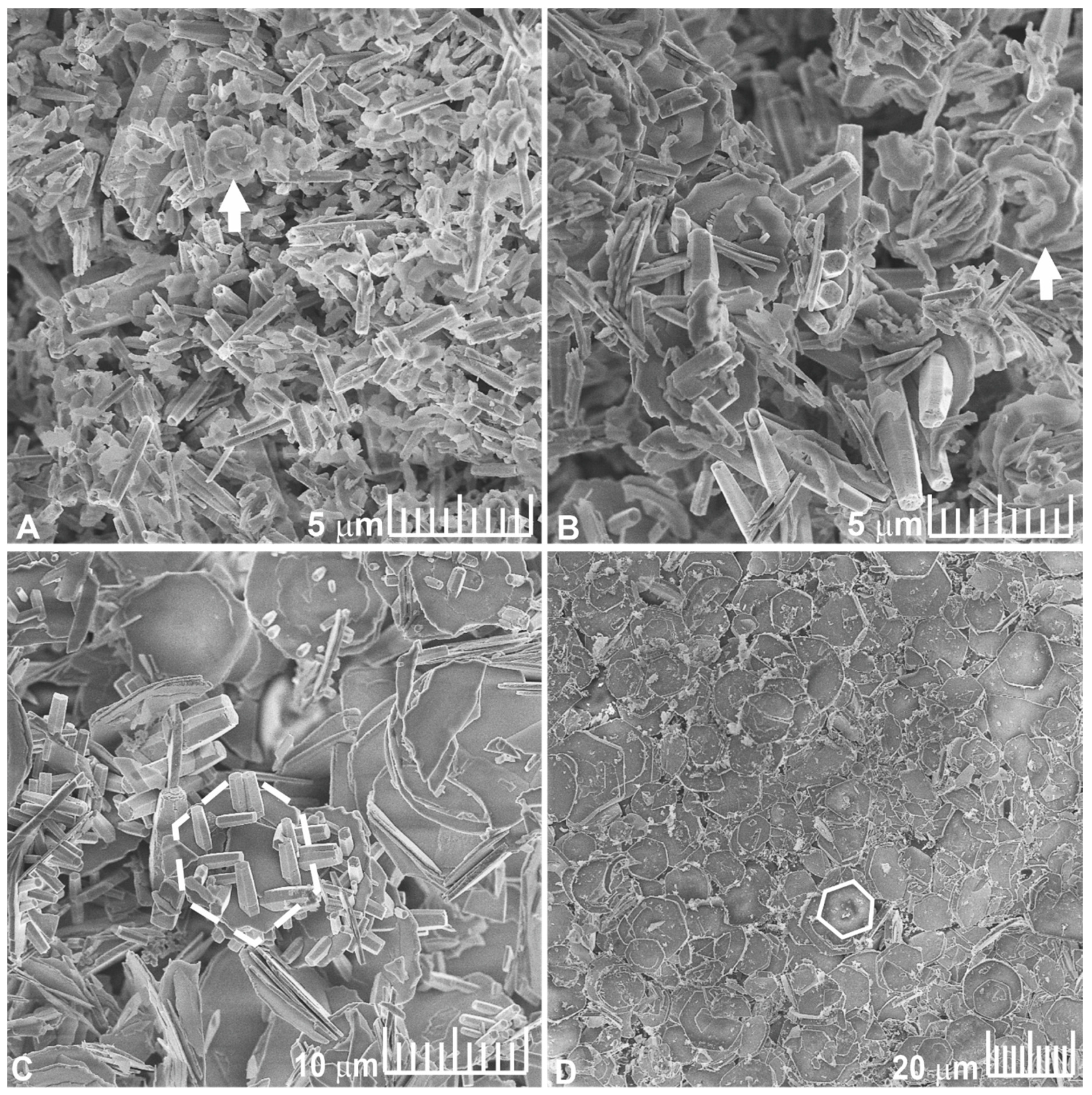

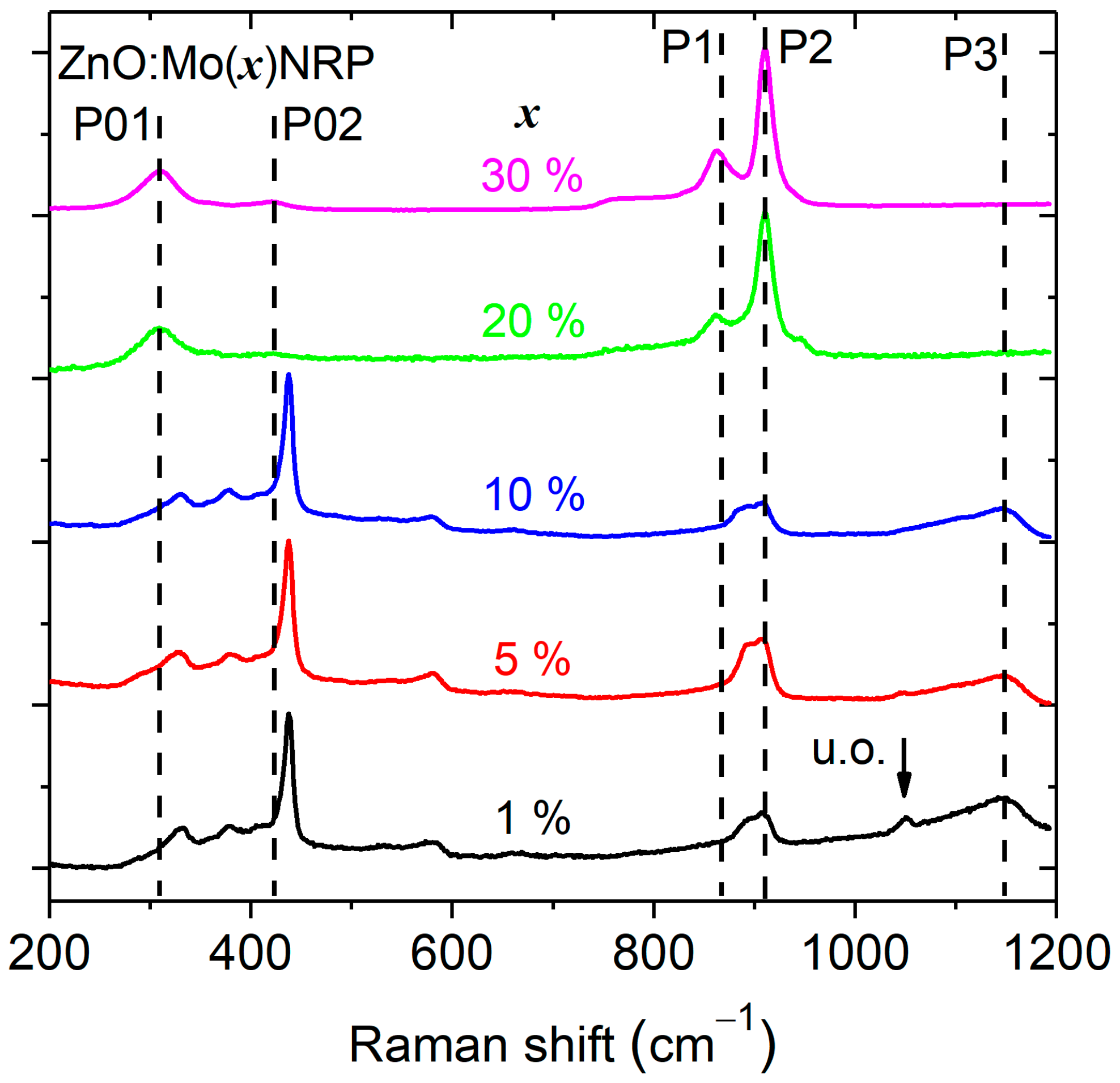
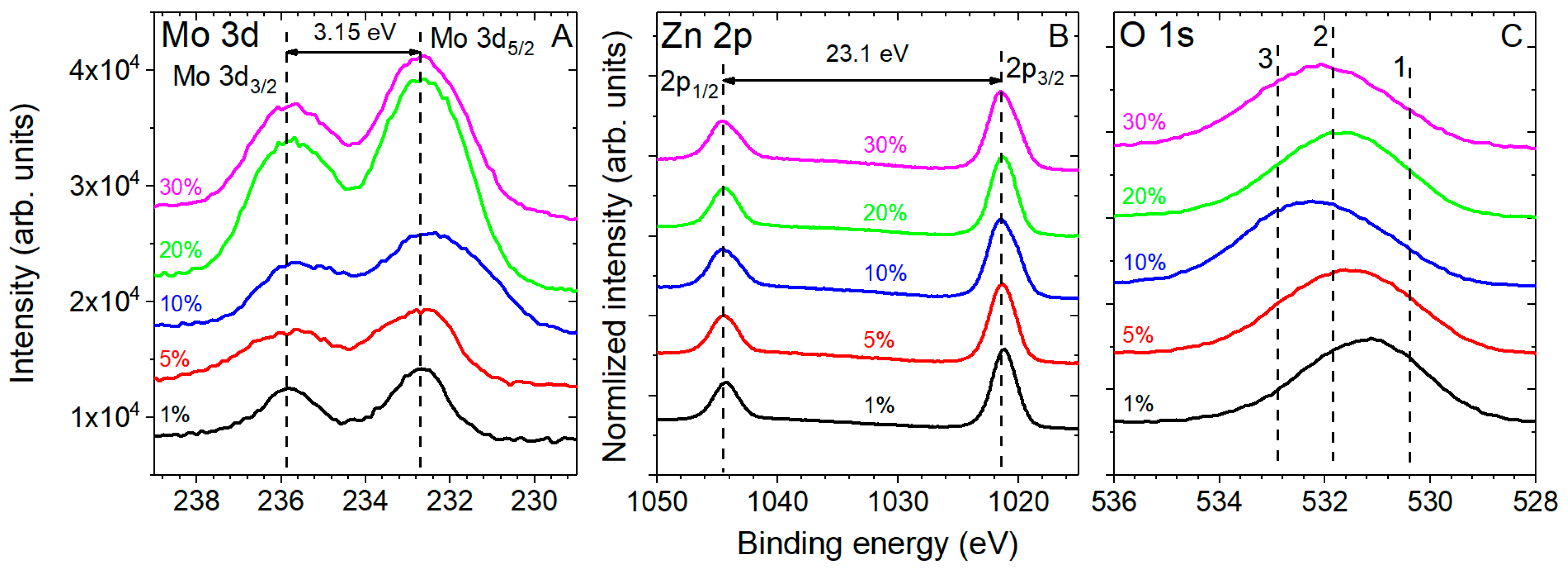

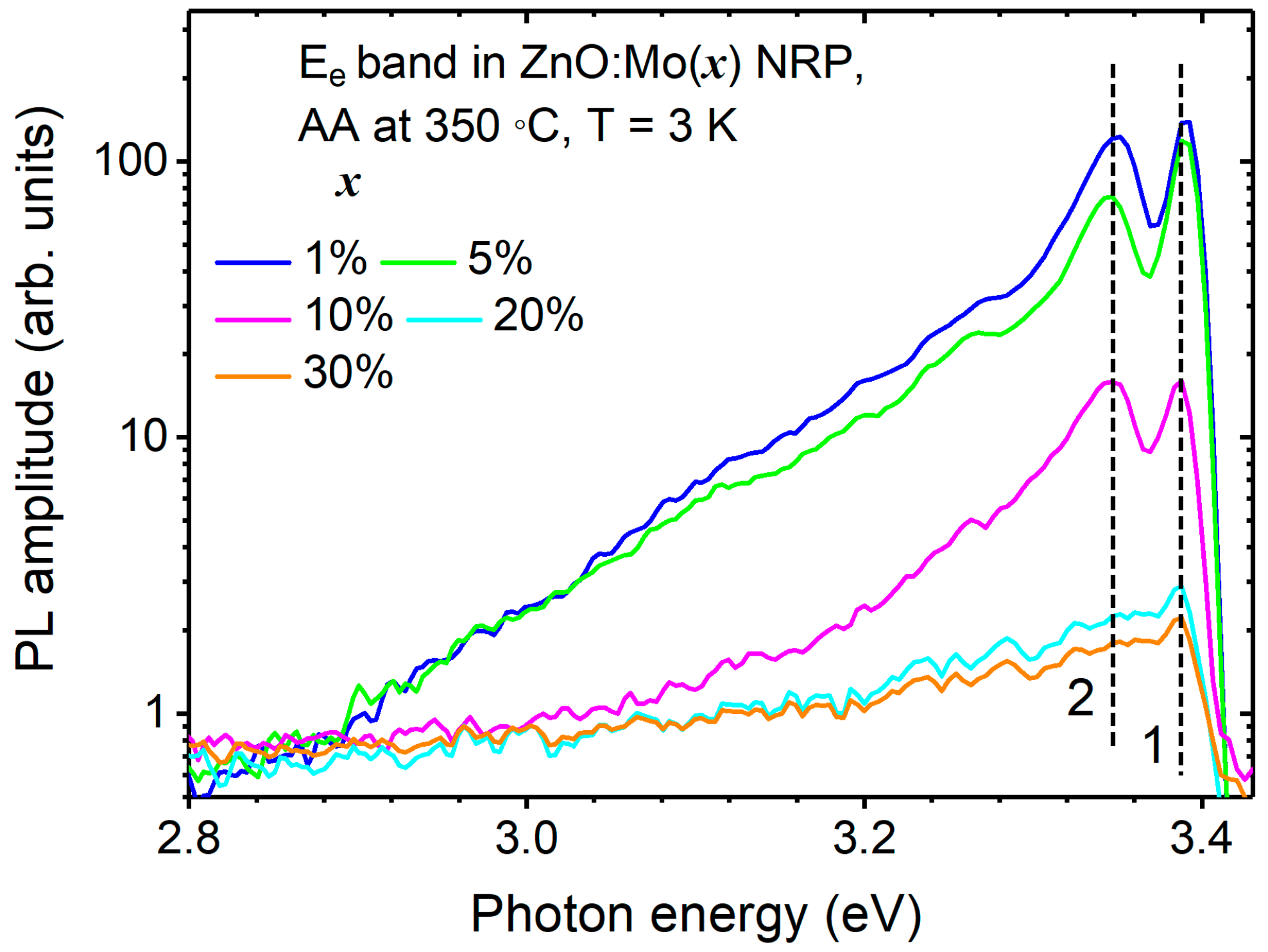
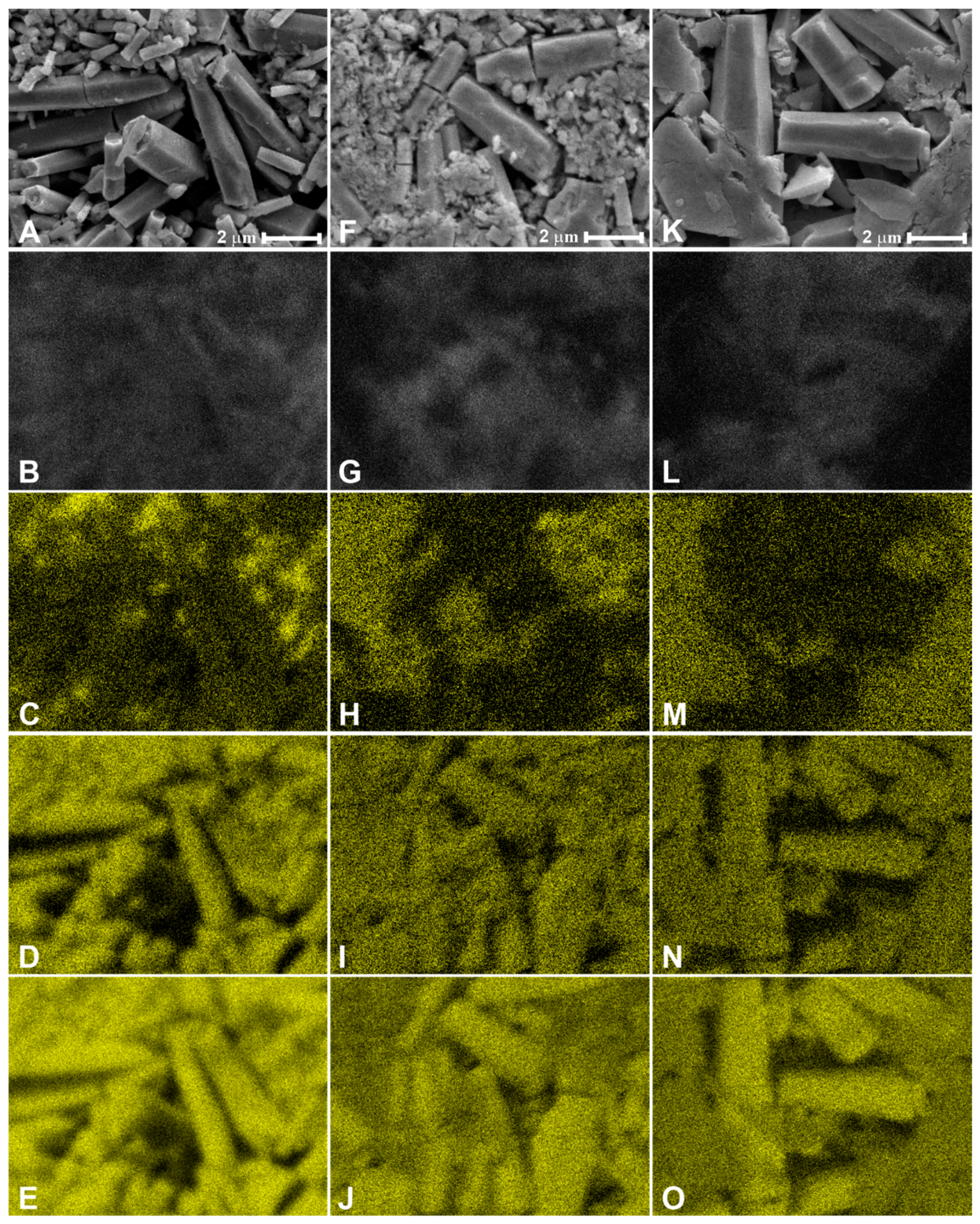
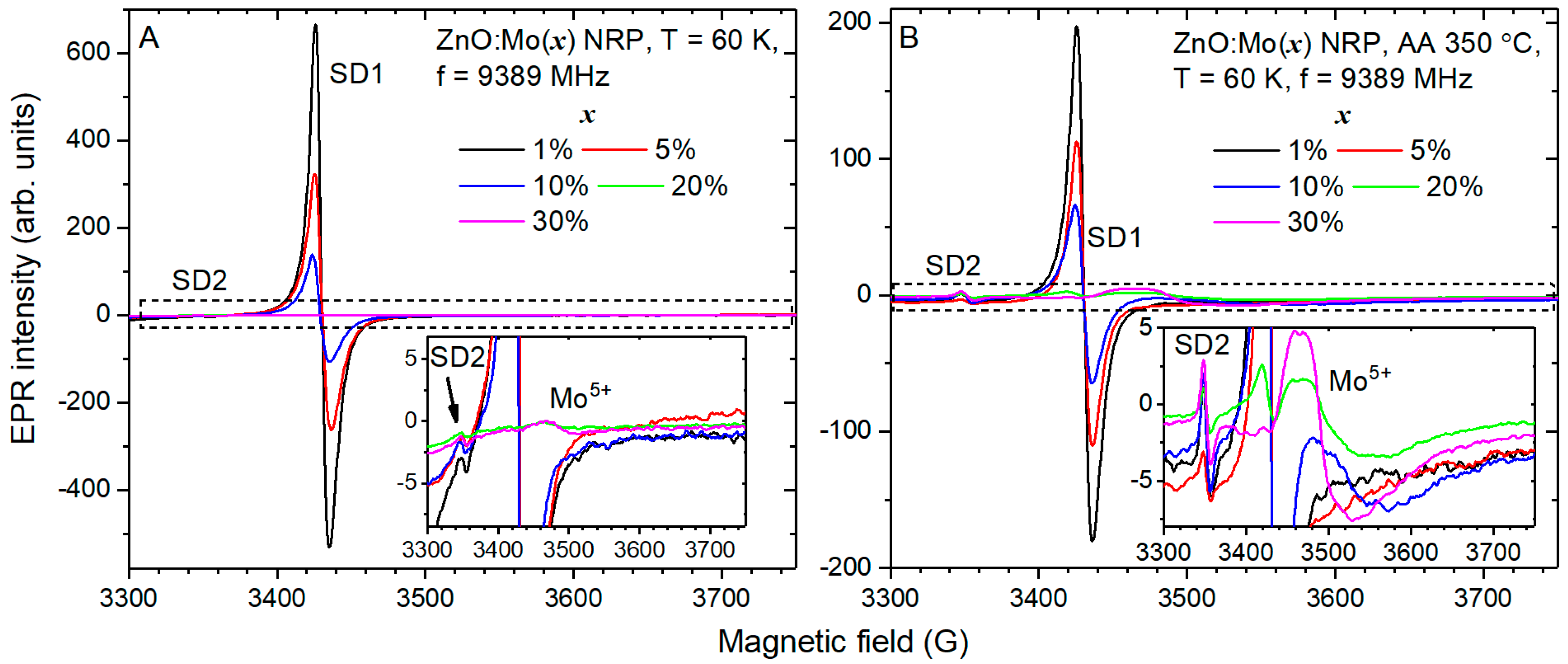
| XPS Region | Chemical Moieties | Binding Energy, eV | Mo Doping Level (at.%) | ||||
|---|---|---|---|---|---|---|---|
| 1.0 | 5.0 | 10.0 | 20.0 | 30.0 | |||
| Fraction of Moieties and Bonds (at.%) | |||||||
| Mo 3d | Mo6+ | 233.1 ± 0.3 | 1.6 ± 0.2 | 2.5 ± 0.4 | 5.3 ± 0.1 | 6.0 ± 0.1 | 5.4 ± 0.6 |
| C 1s | C-C, C-H | 285.0 ± 0.2 | 16.0 ± 1.6 | 11.5 ± 3.5 | 10.1 ± 0.8 | 15.8 ± 0.9 | 14.0 ± 1.0 |
| C-O | 286.4 ± 0.2 | 4.5 ± 0.5 | 8.7 ± 2.6 | 12.1 ± 0.9 | 7.1 ± 0.4 | 13.7 ± 0.9 | |
| C(=O)-O | 289.0 ± 0.2 | 3.5 ± 0.4 | 3.4 ± 1.0 | 3.4 ± 0.3 | 2.8 ± 0.2 | 3.8 ± 1.0 | |
| Total C | - | 24 | 23.6 | 25.6 | 25.7 | 31.5 | |
| O 1s | Zn-O-Zn | 530.6 ± 0.2 | 15.3 ± 0.3 | 14.4 ± 1.1 | 14.1 ± 0.3 | 15.8 ± 0.3 | 12.4 ± 0.8 |
| Zn-O-H, Zn-O−, C=O, Si-O Zn-O-Mo | 531.8 ± 0.3 | 25.2 ± 0.5 | 22.7 ± 1.7 | 22.9 ± 0.5 | 24.7 ± 0.4 | 20.7 ± 2.4 | |
| C-O | 533.1 ± 0.2 | 8.6 ± 0.2 | 12.9 ± 1.0 | 13.7 ± 0.4 | 9.8 ± 0.2 | 14.4 ± 1.7 | |
| Total O | - | 49.1 | 50 | 51 | 50.3 | 47.5 | |
| Zn 2p3/2 | Zn2+ | 1022.2 ± 0.4 | 25.3 ± 1.5 | 23.8 ± 3.1 | 18.5 ± 0.8 | 17.9 ± 0.7 | 15.8 ± 2.7 |
| Mo/Zn | 0.06 | 0.11 | 0.29 | 0.34 | 0.34 | ||
| Sample | Treatment | Mo Center | g1 | g2 | g3 | ΔHpp, G | I, arb. Units |
|---|---|---|---|---|---|---|---|
| ZnO:Mo(20%) NRP | As grown | Mo1 | 1.918 | 1.918 | 1.918 | 40 | 70.23 × 105 |
| ZnO:Mo(20%) NRP | As grown | Mo2 | 1.938 | 1.925 | 1.890 | 20 | 11.70 × 105 |
| ZnO:Mo(30%) NRP | As grown | Mo1 | 1.918 | 1.918 | 1.918 | 40 | 119.38 × 105 |
| ZnO:Mo(30%) NRP | As grown | Mo2 | 1.938 | 1.925 | 1.890 | 20 | 198.95 × 105 |
| ZnO:Mo(10%) NRP | AA 350 °C | Mo1′ | 1.908 | 1.908 | 1.908 | 110 | 331.67 × 105 |
| ZnO:Mo(20%) NRP | AA 350 °C | Mo1′ | 1.908 | 1.908 | 1.908 | 110 | 21.77 × 105 |
| ZnO:Mo(20%) NRP | AA 350 °C | Mo2′ | 1.936 | 1.925 | 1.896 | 40 | 3.98 × 105 |
| ZnO:Mo(30%) NRP | AA 350 °C | Mo2′ | 1.936 | 1.925 | 1.896 | 40 | 8.85 × 105 |
| ZnO:Mo(30%) NRP | AA 350 °C | Mo2″ | 1.929 | 1.927 | 1.872 | 53 | 25.31 × 105 |
Disclaimer/Publisher’s Note: The statements, opinions and data contained in all publications are solely those of the individual author(s) and contributor(s) and not of MDPI and/or the editor(s). MDPI and/or the editor(s) disclaim responsibility for any injury to people or property resulting from any ideas, methods, instructions or products referred to in the content. |
© 2023 by the authors. Licensee MDPI, Basel, Switzerland. This article is an open access article distributed under the terms and conditions of the Creative Commons Attribution (CC BY) license (https://creativecommons.org/licenses/by/4.0/).
Share and Cite
Buryi, M.; Babin, V.; Neykova, N.; Wang, Y.-M.; Remeš, Z.; Ridzoňová, K.; Dominec, F.; Davydova, M.; Drahokoupil, J.; Chertopalov, S.; et al. Changes to Material Phase and Morphology Due to High-Level Molybdenum Doping of ZnO Nanorods: Influence on Luminescence and Defects. Materials 2023, 16, 3294. https://doi.org/10.3390/ma16093294
Buryi M, Babin V, Neykova N, Wang Y-M, Remeš Z, Ridzoňová K, Dominec F, Davydova M, Drahokoupil J, Chertopalov S, et al. Changes to Material Phase and Morphology Due to High-Level Molybdenum Doping of ZnO Nanorods: Influence on Luminescence and Defects. Materials. 2023; 16(9):3294. https://doi.org/10.3390/ma16093294
Chicago/Turabian StyleBuryi, Maksym, Vladimir Babin, Neda Neykova, Yu-Min Wang, Zdeněk Remeš, Katarína Ridzoňová, Filip Dominec, Marina Davydova, Jan Drahokoupil, Sergii Chertopalov, and et al. 2023. "Changes to Material Phase and Morphology Due to High-Level Molybdenum Doping of ZnO Nanorods: Influence on Luminescence and Defects" Materials 16, no. 9: 3294. https://doi.org/10.3390/ma16093294
APA StyleBuryi, M., Babin, V., Neykova, N., Wang, Y.-M., Remeš, Z., Ridzoňová, K., Dominec, F., Davydova, M., Drahokoupil, J., Chertopalov, S., Landová, L., & Pop-Georgievski, O. (2023). Changes to Material Phase and Morphology Due to High-Level Molybdenum Doping of ZnO Nanorods: Influence on Luminescence and Defects. Materials, 16(9), 3294. https://doi.org/10.3390/ma16093294






